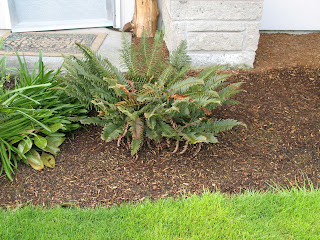Well, not really problems so much as learning experiences. And I will tell you, it has taken quite a bit of courage to admit that after more then 35 years in the landscape maintenance business, and after believing I was really quite an impressive gardener and horticultural expert that I just don't know all that much about how to grow food.
Just because I know what an Acer palmatum dissectum Atropurpureum is, how to plant and care for it doesn't mean I know what is the best tomato to plant on this particular hillside just south of Milwaukie. Let me tell you, when I went to Fred Meyers garden center to pick up 14 tomato plants, one for each one of my kids gardening group, which seemed like such a simple thing to do, I ran head on into the cruel reality's of the tomato fanciers world. There must have been several dozen different varieties of tomatoes! How was a poor fumble fingered lamebrain like me to know the difference between 'Big Boy' and 'Willamette" tomatoes?
Well, I did manage to get 4 or 5 different varieties for my 14 kids. But then came time to plant the little things. Does anyone else know about the unofficial 'rule' about not planting tomatoes before Mothers Day? One of the kinder and sweeter of the other gardeners down in the gardens told me about this planting 'rule'; but for her I would have put the tender little tomato starts in a good two weeks early, and who knows what would have happened then? But I did get them in, even scrounged some tomato cages to put around them, but I am beginning to wonder if the patio variety tomato really needs that huge cage? Time will tell I suppose.
Oh, and need I say it? My tomatoes are some of the smallest in the entire garden area!
And then there are the potato plants. I managed to find some seed potatoes at one of the garden centers about a month ago, they were in a big bag and all of them were already sprouting out and looking really strange. But I handed them to several of the kids to plant one fine Wednesday, and away they went, digging holes sticking seed potatoes in. And yes I did insist that they plant them with the sprouting parts pointed up, although I'm pretty sure at least one of the kids didn't listen to that little piece of advice. And now I'm finding strange vacancies in several places in the potato rows and several suspiciously potato-y looking plants in rows where they aren't supposed to be any potatoes.
And of course one of the other gardeners here in the garden area planted his potatoes at least one or two weeks after we planted ours, and his are at least twice the size of ours! I have some serious potato envy.
But it hasn't been all troubles and tribulations. We harvested the radishes and arugula that the kids planted when then first started coming over and that was a big success. Each of the kids took home a handful of radishes and a handful of arugula. That was a really good day, we even got to take a huge amount of radish and arugula up to the main RV kitchen. What the kitchen boss, Brian was going to do with at least several hundred radishes is not my problem. Did anyone have any of that puff pastry thing stuffed with cheese and our home grown arugula? I tried several and they were wonderful. Thanks Brian.
And then one fine day I noticed that there was some rhubarb in the plot where my grapes are planted; will wonders never cease. I checked around and found out it was time to harvest the succulent stalks, so I did and left them with the kitchen boss Brian. I ran out the back door of the kitchen before he had time to do anything more then mumble something about rhubarb sauce. I'll have to check back with him later to see what he did with the rhubarb.
I picked and ate a strawberry from one of the plants down in the gardens this week, I'm not that fond of strawberries but somehow this one was extra good. More are coming up ripe every day, I can see now that one of my mistakes was not planting enough strawberry plants.They are coming ripe just about as fast as I can eat them, so there may not be many that make it up to the kitchen.
Speaking of strawberries; there are some strawberries in the Health Center patio area that are almost ready to be picked as well as the blueberries. The fig tree and the apricot tree are doing great as well as the herbs. If you happen to go out in the patio area however, stay away from the blue flowered ceanothus, it's really attracting bees right now.
IMPORTANT UPDATE;
We just recieved a donation of 108 tomato plants and various other pepper plants. We now have a grand total of 94 tomato plants planted down in the garden, I'll be putting 6 tomato plants into the health center patio area and I have 22 tomato plants left over. I've done the math on this and it's a bit scary; if each tomato plant produces 100 tomatos we could have aroung 9,400 tomatos this summer! We may be sneaking bags of tomatos onto neighbors front poarches at night just to get rid of them.
But that's enough of my problems
Happy gardening to you
Sedgewick
 hat came in quite unexpectedly yesterday
hat came in quite unexpectedly yesterday .
. hat came in quite unexpectedly yesterday
hat came in quite unexpectedly yesterday .
.



















































